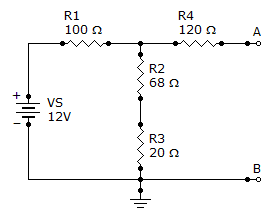Practice Test: Question Set - 01
1. Find the current in R2 of the given circuit, using the superposition theorem.
- (A) 16.7 mA
- (B) 33.3 mA
- (C) 50 mA
- (D) 16.6
mA
2. A 120 Ω load is connected across an ideal voltage source with VS = 12 V. The voltage across the load is
- (A) 0 V
- (B) 12 V
- (C) 120
V
- (D) Cannot
be determined
3. Find the Thevenin equivalent (VTH and RTH) between terminals A and B of the circuit given.
- (A) 562
mV, 167 Ω
- (B) 5.62 V,
167 Ω
- (C) 5.62 V,
188 Ω
- (D) 562
mV, 188 Ω
4. You cannot convert a voltage source to an equivalent current source, or vice versa.
- (A) True
- (B) False
5. A certain current source has the values IS = 4 µA and RS = 1.2 MΩ. The values for an equivalent voltage source are
- (A) 4.8 μV, 1.2 MΩ
- (B) 1 V, 1.2 MΩ
- (C) 4.8 V, 4.8 MΩ
- (D) 4.8 V, 1.2 MΩ
6. Some circuits require more than one voltage or current source.
- (A) True
- (B) False
7. Find the Norton circuit, that is, IIN and RN, for the circuit given below.
- (A) 478 mA,
12.8 Ω
- (B) 750
mA, 12.8 Ω
- (C) 478 mA,
6.8 Ω
- (D) 750 mA,
6.8 Ω
8. An ideal current source has zero internal resistance.
- (A) True
- (B) False
9. Conversions between delta-type and wye-type circuit arrangements are useful in certain specialized applications.
- (A) True
- (B) False
10. A 2 Ω RL is connected across a voltage source, VS, of 110 V. The source's internal resistance is 24 Ω. What is the output voltage across the load?
- (A) 8.5 V
- (B) 85 V
- (C) 0 V
- (D) 110 V
Next Tests:



